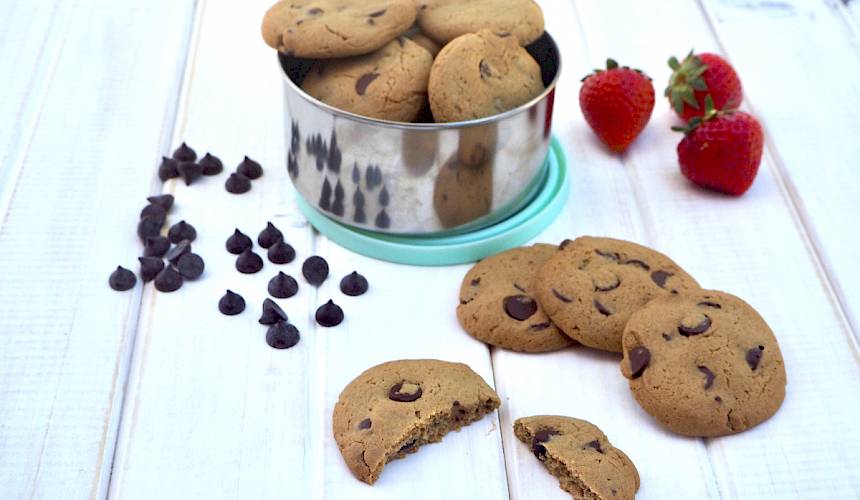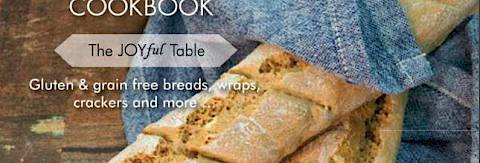
Chocolate Chip Cookies (nut-free)
- Serves: 35
- Prep Time: 00:15
- Cooking Time: 00:14
These are lovely crisp chocolate chip cookies. They keep their crunch even after being stored for several days thanks to using cassava flour. They are the perfect nut-free cookie for kids lunchboxes. Cassava flour is made from a vegetable and is a great option for healthy baking, if you haven't used it before, you can find out more information HERE in my ingredient menu (you will also find a discount for the JOYful Table followers from Three Spades Cassava Flour).
Ingredients
* Please click on the green icon next to the ingredients listed below for extra details and helpful information.
- 1 cup (160g) cassava flour
- 1/4 cup (32g) arrowroot flour, or tapioca
- 1 tsp baking powder (gluten free)
- 1/4 tsp fine sea salt
- 1/2 - 3/4 cup 70% organic dark chocolate, chips
- 1 Lge egg(s)
- 1/2 cup sunflower butter
- 1/2 cup (125ml) maple syrup (100%)
- 2 tsp vanilla extract (organic)
- 1/4 cup coconut oil, softened
Directions
Preheat the oven to 170c (fan-forced) and line 2 large baking trays with baking paper.
Sift the cassava flour, arrowroot, baking powder and salt into a large bowl. Stir to mix the dry ingredients.
Add the egg, sunflower butter, maple syrup and vanilla to a medium-size bowl and use an electric handheld beater on low to combine to a smooth consistency. Pour in the coconut oil and beat on medium speed to combine everything well.
Pour the wet ingredients into the flour mixture and stir to combine everything well. Add the chocolate chips and stir to distribute evenly throughout the dough. The dough will be very soft, set aside for 2 minutes to thicken a little more before rolling (if you find it's still too sticky after sitting, add a little extra arrowroot).
Scoop out level tablespoons of dough, and roll into balls approximately the size of walnuts. The dough is very soft but it's not sticky and rolls well in your hands. Place on the trays leaving space for the cookies to spread when flattened. Flatten the cookies with your hand or use the flat base of a small glass to press down on the balls to make them as flat as shown in the photo above (they don't spread out much further when cooking).
Cook for 14 - 16 minutes until firm and the edges are just turning golden but the cookie colour only changes slightly (don't overcook), allow the cookies to cool on the trays. They will crispen up further as they cool.
Store the cookies in an airtight container for up to 5 days or freeze for up to 3 months.
You may also like
cassava flour
Cassava flour has been a staple food around the world for centuries. It's native to South America and is presently grown as an annual crop in tropical regions. Cassava is a vegetable and the whole tubular root is peeled, dried and ground down to create a flour (it's not the heavily processed tapioca flour/starch which is only the extracted starch). Cassava flour has a mild flavour, is off-white/cream in colour and is slightly lighter than regular wheat flour but is more absorbent. One cup of all-purpose flour = 2/3 - 3/4 cup of cassava flour, start with less and see how your recipe adapts. I find it's a little like coconut flour in the way that it soaks up liquid and needs an extra egg for binding (all my recipes have been triple-tested). It has the ability to brown and produce a crust when used in baked goods, which often doesn't occur when using gluten-free flours. This paleo flour is free from grains, gluten, soy, nuts, additives and fillers. It's a perfect flour for those doing an autoimmune protocol diet, for nut-free baking, anyone with food allergies or intolerances. Cassava flour is high in potassium and vitamin C, it also contains calcium, vitamin A, folate, magnesium, iron, plus resistant starch, which can improve gut health. The shelf-life of cassava flour is typically much longer than other flours. It can be kept for up to two years and possibly longer if stored in an airtight container in a cool, dark location. Purchase from health food stores or online.
Check out DISCOUNT details: You can purchase online direct from an Australian producer, "Three Spades" (threespades.com.au). Three Spades have been very generous to the JOYful Table followers and have given us a 15% discount on their cassava flour. Use the code JOYFUL15 when purchasing 2 x 2kg bags (4kg or more), add the code when going through the checkout process. Another good brand is Otto's that can be purchased online from iherb.com
arrowroot flour
Arrowroot is a herb, the roots are cultivated for its starch properties. It is used in my recipes as a thickener and I also like combining it with almond meal to produce a much lighter texture, more like a gluten flour. I find the starch helps to bind the ingredients together. You can substitute tapioca flour, which is made from the dried roots of the cassava plant. Tapioca can be used in baking, it has a slightly sweet flavour. However, I do not recommend thickening with tapioca, as it has a stretchy, gummy texture. Supermarkets only sell in very small containers, which is not cost effective. Purchase from baking specialty stores, health food stores or online. ( When substituting for cornflour in recipes, 2 teaspoons arrowroot = 1 tablespoon cornflour/starch).
baking powder (gluten free)
Baking Powder is a rising agent for baked goods. If substituting for baking soda you will need 4 times the quantity. Ensure you purchase a gluten free, no aluminum brand. Alternatively, you can make your own baking powder; 1 teaspoon of baking powder is equal to 1⁄4 teaspoon of baking soda and 1⁄2 teaspoon of cream of tartar. Note, that they should only be combined when preparing your recipe.
sea salt
Organic unbleached, unrefined organic Celtic sea salt or pink Himalayan salt is my salt of choice as these contain healthy minerals and trace elements that our body needs. Regular table salt has been bleached, refined and processed leaving minimal health benefits. If you choose to use regular table salt in my recipes you will need to reduce the quantity or the end result will be to salty.
dark chocolate
In some of my recipes I have used Paleo approved dark chocolate drops/chips, they are dairy, soy, and gluten-free (my favourite brands are, 'Absolute Organic' or 'Chef's Choice' certified organic 70% cacao, purchase online or from health food stores). I also used 70 - 85% organic dark chocolate blocks, they can be broken into pieces or melted for recipe. I also make my own chocolate from: cacao butter or coconut oil, raw cacao powder and sweetened with 100% maple syrup, pinch of sea salt and vanilla extract.
egg(s)
I have used large free range or organic eggs from a 700g carton in my recipes. Eggs are one of the few foods considered to be a complete protein because they contain all 9 essential amino acids, also studies have shown that lutein (yellow colour) in egg yolks protects against the progress of early heart disease.
sunflower butter
Purchase organic if possible or make your own. Choose a brand that contains only toasted sunflower seeds, with no sugar or vegetable oils added. This is perfect to use in place of nut butters. When baking with sunflowers use baking powder (gluten-free), as baking soda (bicarb) reacts to the sunflowers and turns green (it will taste the same but your baking won't look as pleasant to the eye).
maple syrup (100%)
Maple syrup is an earthy, sweet tasting amber liquid that is produced by boiling down the sap of maple trees. Use organic 100% maple syrup which is a natural food sweetener, not a flavoured maple syrup. Pure maple syrup contains a decent amount of some minerals, especially manganese and zinc, some traces of potassium and calcium but it does contain a whole bunch of sugar. I try to reduced the amount of sweetness in each recipe to the lowest possible without compromising taste. Feel free to adjust to your liking. I use maple syrup in place of raw honey when I don't want the strong honey flavour coming through in a recipe. I have paleo cookies and desserts in my cookbook made from whole food ingredients with natural sugars but please don’t overindulge. Use as a treat only for special occasions.
vanilla extract (organic)
Use an organic vanilla extract (not an essence) or vanilla powder. Vanilla makes a big difference to the flavour of a recipe, I recommend keeping to the quantities I have stated in a recipe. I prefer Madagascar pure vanilla extract manufactured by ‘Simply Organic’ and for powder, Vanillamax 100% pure, finely ground Madagascar vanilla beans produced by Bulletproof.
coconut oil
Coconut oil is one of the most nutritious fats to cook and bake with. Use organic extra-virgin coconut oil which is unrefined and unbleached from non GMO coconuts. Coconut oil has a high smoking point and it is slow to oxidize due to its high saturated fat content, thus, resistant to going rancid. Some studies suggest coconut oil helps with digestion, including irritable bowel, tummy bugs, candida and parasites due to this oil containing short term medium-chain saturated fatty acids (MCFAs), which is a healthy form of saturated fat.
















